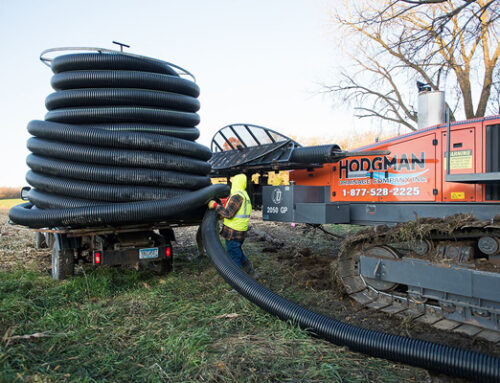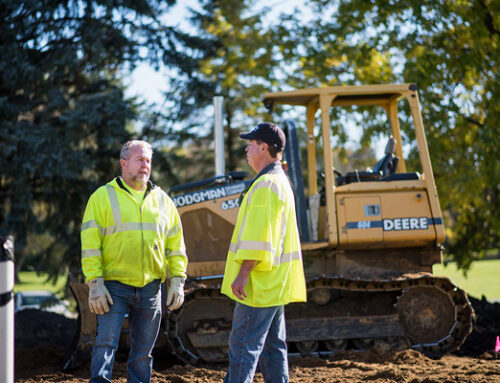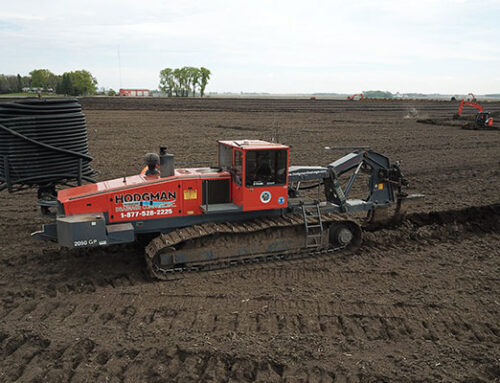Key Takeaways:
- Field tiling comprises a network of perforated PVC pipes that acts as a collection point for various subterranean drains installed in a farm field.
- The drains allow excess surface water to be siphoned off without eroding the soil or displacing mineral-rich sediment.
- Tiling improves the quality of agricultural soil & yield, speeds up silage maturity for livestock, enhances pasture quality in the surrounding habitats, and is a sustainable practice.
- Mole, gravel mole, & interceptor drains are most commonly used along with tiling to maintain suitable water table levels.
- Water pumps can cause a local draw-down effect on the water table. Discuss your options with a professional like Hodgman Drainage Company, Inc. before obtaining a permit for installing a pump.
Well-drained fields have been proven to produce higher yields in farming. That’s why sophisticated drainage methods, like field tiling, exist to deal with the issue of waterlogged & saline soils. The right drainage system installation ensures consistent drainage & replenishment of the soil’s natural nutrients without over-using the soil for farming.
Hodgman Drainage Company, Inc. has been developing & delivering sustainable solutions for residential, agricultural, & municipal drainage since the 1980s. Our solutions are designed with care for the soil & the environment. We have worked with many farmers, families, and corporations to bring their agricultural goals to full-yield fruition!
Wet Soils & Agriculture | Field Tiling
Over-saturated or waterlogged soils gradually break down the organic structure, leading to compaction & poor soil aeration. That can inhibit crop root growth & development, resulting in stunted or failed crop yields. Wet soils also present another problem: enhanced salinity & erosion. With tree & plant roots failing to thrive & keeping the soil together, combined with minimal soil aeration, the top soil weathers faster, taking the organic nutrients along with it.
Soil salinity also results in acidic soils that may further limit the crop species that can be cultivated on the affected land. The agricultural tract might be virtually unusable in a few years with the combined strain of rain, artificial irrigation, poor drainage, and a few crop yields.
What Is a Field Tile, Or Tiling?
They used to be called field tiles because short, perforated clay pipes were initially used. However, they were quite difficult & costly to trench & bury, so PVC pipes replaced them in later designs. Think of them as very advanced French drains.
Tiling is a subterranean collection pipe collecting water from various drain systems interspersed throughout a farm field. The pipe leads to strategically designated outfalls that distribute the runoff without eroding the soil or disrupting the water table.
The Benefits of Proper Field Tiling
While surface drainage, like channels & grooves to collect rainwater, is useful, it only slows down drainage or increases topsoil erosion. Field tiles offer a suitable subsurface solution that hydrates the soil and allows thorough aeration. Combined with field plowing during seeding, the soil is nurtured to optical conditions for maximum crop yield.
Sustainable Farming | Field Tiling
Subsurface drainage offers many long-term & sustainable advantages over traditional surface drains on vast tracts of agricultural land. The presence of oxygen in the soil leads to a healthier rate of nutrient-rich decay that replenishes soil fertility. It also makes the soil more receptive to modern fertilizers, thus reducing the leeching effect more common with poor farming practices.
With controlled surface runoff & reduced sediment erosion, the soil’s mineral imbalances are also restored, and any danger of soil salinity is averted.
Livestock Feed in Abundance
Silage is a form of fermented fodder made from various pasture grasses & crops like alfalfa, barley, sorghum, and corn. It is what livestock farmers feed their herds over the colder months. The harvest of silage crops is very much dependent on the soil quality. Well-drained soils, or land tracts with field tiling, enable fodder crop maturity several weeks in advance in contrast to waterlogged & nutrient-low soils. That ensures that silage stocks are sufficient & high-quality to last the farm over the unfarmed months.
Pasture Quality Enhanced
Field tiling benefits the farmland and the livestock but also helps improve & conserve the surrounding pasture from less desirable plant species that have adapted to waterlogged soils. Drainage helps nurture improved pasture species, thus providing wildlife with nutrient-rich grounds to thrive on.
Types of Drainage Systems
Four basic types of drainage designs are connected to a main tile. They are all made of PVC, which is impervious to acidic soil corrosion or water damage. As is with all tiling methods, the cost of backfilling the drainage trenches is high and should never be compromised.
Natural soil drainage influences the amount of backfill required, with more needed for less permeable soils to drive sufficient subsurface drainage.
Mole Drainage
These are used in poorly drained & dense soils where the natural downward movement of water is limited. They are not suited to well-drained soils as that would disrupt the natural order and lead to reduced soil moisture. They are trenched at 16 to 24 inches and installed in soils that lack permeability, may contain excess aggregates & rocks, or might be far from the outfall.
Sand and finely graded gravel serve as the backfill for the collector pipe, and the mole drains are installed at a right angle to the field tiling. Excess surface runoff flows first into the mole pipes, seeps into the backfill, and collects into the field tile. From there, it travels to the outflow.
Interceptor Drains | Field Tiling
These drains are used on uneven agricultural land & are usually installed at the point steep slopes change gradients to level terrain. Such terrains often have more permeable soil in the incline than the plain. Hence the water might pool on the plain.
The interceptor is installed 1 – 1.5m deep or below such sites, especially if springs are nearby, to control gradual soil erosion from runoff. These sites are usually called soak areas. Interceptor drains, a field tiling with permeable backfill cutting across the area, is the collector that stabilizes the water table in the region.
Gravel Mole Drainage
They are unlined channels packed with fine gravel & sand. This type of drainage is best suited to both dense & well-drained soils across Minnesota. It is ideal for soils too dense to be drained by the moles simply because they have a shorter lifespan in dense soils. They are only suitable for permeable soils if the ground disruption will not affect the integrity of the drain leading to the collection pipe.
Gravel mole drains are expensive because they require a lot of backfill and because there have to be a lot of them in close proximity. However, they are the optimal solutions for soils that are difficult to drain.
Ground Water Pumps | Field Tiling
These pumps help remove excess water from natural aquifers to stabilize the water table for optimal crop farming without adverse environmental effects or spring levels for wildlife. A draw-down effect might be observed in the water table level at the pump site. Still, it depends on the aquifer’s and the water table’s depth and the soil type for pumping to be safely carried out.
You might need a DNR permit to extract water from the ground for farming and soil quality purposes. Discussing your options with an experienced drainage company for optimal drainage systems is best.
Experiencing Diminished Crop Yields of Late?
Crops require an optimal level of soil moisture & oxygenation to thrive better on less acreage. And the soil itself calls for controlled drainage to help cycle the nutrients back & ensure extended farming seasons without straining the land. Field tiling & appropriate drainage help manage farming on wet soils.
If you have legacy drainage systems on your land & need a sustainable solution to diminished crop yields, don’t hesitate to get in touch with Hodgman Drainage Company, Inc. at 507-528-2225. We’re active in Granite Falls, MN, and have been in the agricultural drainage business since the 80s.
Thank you for choosing our services!



